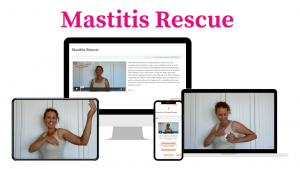"I was told to pump and dump because of mastitis. Do I need to?"
What is Mastitis, and Why Does it Happen?
Mastitis is a common inflammation of breast tissue that can cause redness, pain, and sometimes even a fever. For many breastfeeding mums, it can feel like an unwelcome hurdle during what’s already a demanding time. Mastitis usually happens when milk pressure in the breast builds up and leaks out of the alveoli sacs into the surrounding tissues of the lobe, creating a breeding ground for bacteria, which then may lead to infection.
One question that naturally comes up is whether mastitis inflammation, and/or a mastitis infection affects the milk itself and whether it’s safe for the baby. The good news? Your milk is still safe and nutritious for your little one. So no stress!
Breast Milk is Safe, Even During Mastitis
Breast milk is specifically designed to nourish and protect your baby, containing antibodies, nutrients, and protective enzymes tailored to your baby’s needs. Even when mastitis is present, the breast milk itself remains safe. Any bacteria that may be involved in the mastitis infection is naturally occurring in the breast milk. It's just that now it has leaked out of the milk sacs it has the potential to grow in number in the highly inflamed environment. It's the heat and stagnancy that is the key focus for mastitis treatment.
Yes the milk will still contain bacteria, BUT it is meant to my friend. So, you can rest assured that your baby’s feedings are still providing them with all the benefits of breastfeeding—nutrients, hydration, and comfort.
Did you know?
- Mastitis affects about one in five breastfeeding mothers and is the inflammation of breast tissue commonly caused by a blocked milk duct.
- The Australian Breastfeeding Association says more research is needed to help health professionals prescribe the most effective treatments.
But Wait, Why Might the Milk Taste Different?
One side effect of mastitis that may catch you off guard is that your breast milk can sometimes taste a bit different when you’re dealing with this inflammation. As your body fights off the infection, the composition of the milk can shift slightly, causing it to taste a bit saltier than usual.
This saltier taste won’t harm your baby in any way, but some babies might notice it and may react to the difference. It’s like when you accidentally buy the "unsweetened" version of your favorite almond milk—you can tell it’s different, but it’s still safe to drink. The same goes for your baby.
BE KIND TO YOU!
It's not PUS coming out of your nipple.
It's different coloured milk (a bit like colostrum) from the affects of the high-inflammation that IS mastitis. It is safe for baby! It looks a lot like pus but it's all ok!
If Baby Rejects the Milk, Don't Worry!
In some cases, you may notice that your baby is fussy or less interested in nursing. This could simply be because of the temporary saltiness of the milk. If that happens, don’t worry. This is common, and it doesn’t mean anything is wrong with your milk. It just means that baby’s taste buds are noticing the change.
The good news? This salty taste isn’t permanent! As the inflammation from mastitis subsides, your milk’s flavor will go back to its usual sweet, familiar taste, and your baby will likely have no problem nursing. In the meantime, keep offering the breast as usual. Even if your baby is less interested for a few feedings, they’ll likely adjust or start nursing normally again soon.


Why Nursing Through Mastitis is Actually Beneficial
Here’s a bonus: continuing to breastfeed through mastitis is often recommended because it is important to keep milk flowing but only at the frequency of your regular routine. When your baby feeds, they’re helping keep the milk flowing, which can ease the pressure in the breast and get you on the road to recovery faster. Plus, the skin-to-skin contact during breastfeeding can be comforting for both you and your baby, making the experience less stressful.
What if Nursing is Painful?
It’s no secret that nursing with mastitis can hurt. To make it a bit easier, try nursing on the unaffected breast first to stimulate letdown, then switch to the side with mastitis. Warm compresses before nursing and gentle massage may also help ease some of the pain. And, as always, staying well-hydrated and getting as much rest as possible will support your body’s healing.
Trust Yourself and Stay the Course?
Breastfeeding through mastitis can be challenging, but it’s also incredibly beneficial for both you and your baby. Your milk is still perfectly safe, even if it tastes a bit different. Remember, this salty phase won’t last forever—soon, your milk will taste just the way your baby loves, and nursing will feel a bit easier again.
By continuing to nurse, you’re not only feeding your baby but also helping clear the milk to reduce the inflammation, and supporting your body’s natural healing process. So hang in there, and don’t hesitate to reach out to a lactation consultant or healthcare provider if you need extra support.

Author: Dr Katie Willy
Osteopath & Your Two Jugs Co-Founder

Elise Fuller & Katie Willy
Osteopaths & Your Two Jugs Co-Founders
Elise & Katie are Melbourne based osteopaths who have been actively treating breastfeeding women in clinic since 2015. During 2020 lockdown they launched Your Two Jugs to educate more mamas about how to treat their own mastitis, blocked ducts and engorgement. Their online video based courses Boobology and Mastitis Rescue is available now with all the techniques we show our mamas in clinic.
Your Two Jugs is passionate about support for mamas from the top. Boob Hero is a comprehensive health care practitioner course to educate manual therapists on their contribution to supporting breastfeeding women with hands on care. Empowerment all starts with education, and the more support available for women, the better.




